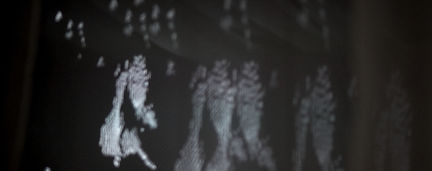THE DREAMS OF MACHINE
“ Do Androids Dream of Electric Sheep ? ”
INTRODUCTION
The dreams of the machine is an immersive space in the form of mapping, exploring the relationship between humans and machines, and also how technology might become an extension of physical virtual reality. As we create technologies, these codes become carriers, and hence extensions, of our intentions.

INSPIRATION
I have a hobby (often on the Internet): I search for people’s descriptions of their many strange dreams. Because I am a person who rarely dreams, I have no memory of dreams almost every night. In July 2019, I spent every day mulling over the theme of my project, until one day at noon, when I took a nap and had a dream. I am still very impressed. The dream felt very real to me. In this dream, my white teeth turned black. I woke up from the dream but found out I was still dreaming. I realised it was a dream within a dream. When I actually woke up and my mind got back to reality, I began to wonder: if computers could dream and machines could imagine, what kind of dreams would they have?

Technical
Keywords: Machine Performance, Physical Structure, Projection Mapping, Immersive Environment, Memory, Servo, 3D Printing, dream, Arduino, openFrameworks, Mas/Msp, 3D Model Building.
Technically, I used processing and openframworks and added a Kinect interactive device. I used openframworks and processing to create nearly ten different animated visual effects in a binary system to simulate a machine's dreams. According to human dream research, the average person dreams 2-5 dreams a night, so I also set my robot dream theme to 2-7 dream effects that rotate regularly.
In terms of presentation, I wanted to create an immersive space where the viewer can more or less feel the "dream". With the curtain as the boundary, I built an area about 4 meters long, 4 meters wide and 3 meters high. Seven layers of projection yarns are suspended in the middle of the space, and a visual effect made with processing and the open framework is projected onto the yarns. Let the viewer be free to shuttle between different layers of yarn to feel the "dream". And in the left corner, there's a Kinect. If the Kinect detect a people, the people will be projected onto the veil and sees his or her body become zero and one. Because assuming that a machine can dream, then the dream of the machine should be in its storage space, should be able to be found by humans, and find itself in the dream of the machine like this.
1.0

4.0

2.0

5.0

3.0

6.0

7.0

7.0
Since there's an old Chinese saying that you think about something every day and dream about it every night, I started to assume that if a machine could dream. Would the machine’s dream have anything to do with what humans are using it for during the day? Do machines dream in characters and words, or in videos at night: for example, a word document or a film on a computer? I classify machine dreams into four categories: 1) text, 2) image, 3) sound, 4) image. I then go on to research, set aside artificial intelligence and machine learning, and treat computers like TV tools, only used by humans, not learning on their own.
To a simple computer, then, because of the binary system, all the words, symbols and sounds might not mean anything but just zeros and ones.
The base-2 numeral system is a positional notation with a radix of 2. Each digit is referred to as a bit. Because of its straightforward implementation in digital electronic circuitry using logic gates, the binary system is used by almost all modern computers and computer-based devices.


SEE YOURSELF IN THE DREAM
When people walk Into The dreams of a machine If the Kinect detect them, their body will become zero and one in the "dream".
THE DREAMS OF MACHINE
“ Do Androids Dream of Electric Sheep ? ”



PROGRESS



